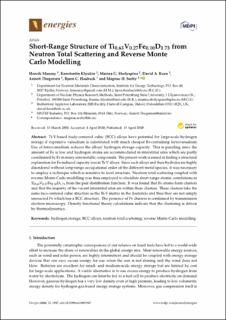| dc.contributor.author | Mauroy, Henrik | |
| dc.contributor.author | Klyukin, Konstantin | |
| dc.contributor.author | Shelyapina, Marina G. | |
| dc.contributor.author | Keen, David A. | |
| dc.contributor.author | Thøgersen, Annett | |
| dc.contributor.author | Hauback, Bjørn | |
| dc.contributor.author | Sørby, Magnus Helgerud | |
| dc.date.accessioned | 2022-05-27T08:31:06Z | |
| dc.date.available | 2022-05-27T08:31:06Z | |
| dc.date.created | 2020-05-11T09:09:51Z | |
| dc.date.issued | 2020 | |
| dc.identifier.citation | Energies. 2020, 13 (8), . | en_US |
| dc.identifier.issn | 1996-1073 | |
| dc.identifier.uri | https://hdl.handle.net/11250/2996356 | |
| dc.description.abstract | Ti-V-based body-centered cubic (BCC) alloys have potential for large-scale hydrogen storage if expensive vanadium is substituted with much cheaper Fe-containing ferrovanadium. Use of ferrovanadium reduces the alloys’ hydrogen storage capacity. This is puzzling since the amount of Fe is low and hydrogen atoms are accommodated in interstitial sites which are partly coordinated by Fe in many intermetallic compounds. The present work is aimed at finding a structural explanation for Fe-induced capacity loss in Ti-V alloys. Since such alloys and their hydrides are highly disordered without long-range occupational order of the different metal species, it was necessary to employ a technique which is sensitive to local structure. Neutron total scattering coupled with reverse Monte Carlo modelling was thus employed to elucidate short-range atomic correlations in Ti0.63V0.27Fe0.10D1.73 from the pair distribution function. It was found that Fe atoms form clusters and that the majority of the vacant interstitial sites are within these clusters. These clusters take the same face-centered cubic structure as the Ti-V matrix in the deuteride and thus they are not simply unreacted Fe which has a BCC structure. The presence of Fe clusters is confirmed by transmission electron microscopy. Density functional theory calculations indicate that the clustering is driven by thermodynamics. | en_US |
| dc.language.iso | eng | en_US |
| dc.publisher | MDPI | en_US |
| dc.rights | Navngivelse 4.0 Internasjonal | * |
| dc.rights.uri | http://creativecommons.org/licenses/by/4.0/deed.no | * |
| dc.subject | Monte Carlo modelling | en_US |
| dc.subject | reverse | en_US |
| dc.subject | neutron total scattering | en_US |
| dc.subject | BCC alloys | en_US |
| dc.subject | hydrogen storage | en_US |
| dc.title | Short-Range Structure of Ti0.63V0.27Fe0.10D1.73 from Neutron Total Scattering and Reverse Monte Carlo Modelling | en_US |
| dc.type | Peer reviewed | en_US |
| dc.type | Journal article | en_US |
| dc.description.version | publishedVersion | en_US |
| dc.rights.holder | © 2020 by the authors. Licensee MDPI, Basel, Switzerland. This article is an open access article distributed under the terms and conditions of the Creative Commons Attribution (CC BY) license (http://creativecommons.org/licenses/by/4.0/). | en_US |
| dc.source.pagenumber | 14 | en_US |
| dc.source.volume | 13 | en_US |
| dc.source.journal | Energies | en_US |
| dc.source.issue | 8 | en_US |
| dc.identifier.doi | 10.3390/en13081947 | |
| dc.identifier.cristin | 1810176 | |
| dc.relation.project | Norges forskningsråd: 218409 | en_US |
| dc.source.articlenumber | 1947 | en_US |
| cristin.ispublished | true | |
| cristin.fulltext | original | |
| cristin.qualitycode | 1 | |

